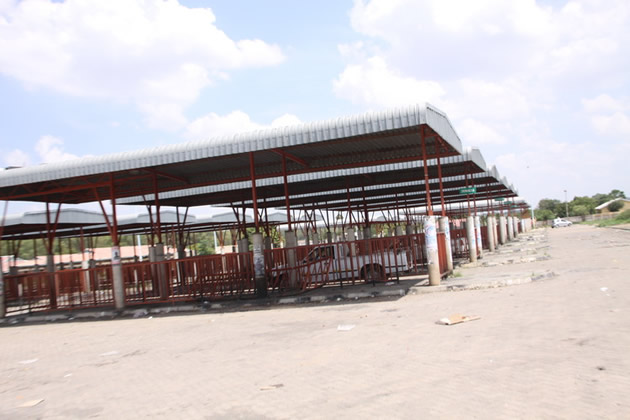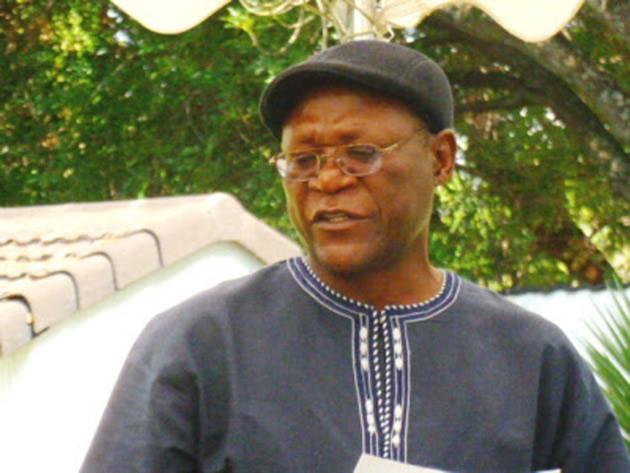Going to waste . . .

Fortious Nhambura Senior Features Writer
The place is deserted. There is no movement in the complex save for a security guard manning the entrance. There is no smoke from the chimneys, no noise from the machines or workmen and women traversing the yard of the Transload Biodiesel Plant complex in Mt Hampden.
After sometime a lone figure appears from one of the guardrooms along the perimeter fence visibly in no hurry to attend to us.
“Where are you from? The place has been closed for nearly a year now. There is no production here and people are not allowed here.
“Please do not take pictures. This is Reserve Bank of Zimbabwe property and you cannot take photographs,” said the guard manning the gates of the multimillion0-dollar complex that was constructed at the height of illegal sanctions-induced fuel shortages in 2007.
The place is now a pale shadow of the complex that was commissioned by President Mugabe a few years ago. It has clearly turned into a white elephant.
Located 15 kilometres northwest of Harare, the imposing plant has become a giant ghost in the area.
It is a clear sign of what can happen to an investment if there is lack of fore-planning and when politics override the will for development.
The plant is one of many multimillion-dollar structures that were erected but have been abandoned and turned to white elephants over the years.
Among other massive investment projects that have turned into white elephants in Harare and Chitungwiza are the Chitungwiza Aquatic Complex, the Magamba Hockey Stadium (all constructed when Zimbabwe hosted the 1995 All-Africa Games), and the Harare Centenary Bridge in the CBD and Machipisa bus terminus and a footbridge that were constructed as part of Harare centenary celebrations during the City of Harare’s Executive Mayor Solomon Tavengwa era.
The Transload Biodiesel plant, a joint venture between the RBZ and South Korean firm Yuan Woo Investments, was officially commissioned by President Mugabe on November 16, 2007.
It is one of the largest biodiesel plants in the world with a capacity to produce 100 million litres of biodiesel annually when operating at peak but that has never been realised.
“It is disheartening to see such a massive investment going to waste. The project was supposed to shine as it came as one of the sanctions-busting measures by our Government.
“It was a welcome development for a country that was facing shortage of fuel due caused by the illegal sanctions imposed on Zimbabwe by the West.
“Government should not let such projects rot but come up with a way of resuscitating them for the good of the country,” said Mr Fredrick Manyangarerwa, a social and economic analyst.
Unfortunately the multimillion dollar investment has not pumped any oil, not to 50 percent capacity, not 25 percent or even 10 percent of the installed capacity.
Reason: the country failed to provide enough feedstock from cotton seed, soya beans, jatropha and sunflower seed.
Zimbabwe Farmers Union vice president Mr Berean Mukwende said there was need for policy makers to prioritise and focus energies and resources on ensuring that such infrastructure like the Mt Hampden biodiesel plant start production.
“There is so much value that is locked in these infrastructures that should be used for the benefit of the people. Government should not just look at the immediate financial benefits but other factors like social and political impact of focusing on importing and not production.
“If the plant is resuscitated it will mean jobs for the local people and markets for farmers. That is what we should consider before making decisions,” he said.
Said a Harare-based political analyst who declined to be named: “That is a reflection of the decline we have witnessed in agriculture. The sector was supposed to give enough stock for pressing but it has not been pumping and that is reflected by the silence at the biodiesel plant.
“It shows that politics should never be used to stall development. The MDC fought against these projects and look what we have now, a multimillion dollar investment that is not in use.”
With the plant operating at capacity the country was supposed to serve between US$50 million and US$70 million.
Despite efforts by the national biodiesel feedstock production taskforce to promote the growing of jatropha and other oil seeds, lack of funding saw many projects that had been instituted to grow feedstock for the plant folding.
The growing of jatropha and other oil seeds across Zimbabwe came to naught due to lack of funding and low producer prices for jatropha seed that forced farmers to abandon the plant for other crops.
The Chitungwiza Aquatic Complex, built to host the 1995 All Africa Games swimming championships, is now in an embarrassing state of neglect.
Equipped with an Olympic size swimming pool, a practice and children’s pool, the complex was the darling for all serious swimmers.
It also boasted of electronic timing equipment and a boiler house that warmed water to allow year-round swimming.
The swimming complex, once the home of swimming that saw sporting heroes like Kirsty Coventry emerge as the world’s super brands, only carries memories as it decays by the day.
The Aquatic Complex has now been turned into an entertainment and cultural joint instead of a swimming centre. It is now famous for hosting musical gigs and weddings, something that was never part of the dream at its construction.
Now famous at the complex is the Aquatic Complex Nite Club, not the swimming pool.
Even residents of Zengeza are complaining of the noise coming out of the complex every weekend.
“We are not used to nose from the centre. Sometimes the noise is so unbearable but there is nothing we can do. We welcomed the construction of the centre but it has failed to deliver its purpose,” said Mrs Melody Mangena of Zengeza 4.
Efforts to rehabilitate Chitungwiza Aquatic Centre have been unsuccessful as the Government struggles to raise the US$2,5 million needed for its restoration.
A visit to complex revealed that Government through the Ministry of Local Government, Public Works and National Housing is doing minor repairs to the hall and not the pool.
The Sports and Recreation Commission last year surrendered the state of the art facility to Government in the hope that it would be renovated.
Also neglected is Magamba Hockey Stadium. The neglect has seen turf disintegrated and become unusable although in the past years they hosted major international events such as the All-Africa Games in 1995.
The stadium is no longer fit for hockey and has been turned into a “church” and a venue for musical shows.
Not only Government structures have turned into white elephants but also those owned by the City of Harare.
For example, the Harare centenary bridge and the Machipisa footbridge and long distance bus termini that were built in celebration of the city’s 100 years anniversary lie “naked”.
The structures were constructed at a tune of Z$23 million.
Built in 1998, the Centenary Bridge joins Town House and Joina City complex over the busy Julius Nyerere Way. It was constructed in such a way that it would give people a 360 degree view of the city and a bird’s eye view of Harare in motion.
People are not enjoying the pleasure of the bridge as it was closed due to neglect. In fact the bridge had become a “toilet” for street children, making it an eyesore for the city eventually forcing the city to close it.
The bridge was a joint venture between the City of Harare and Delta Corporation.
The company in turn was allocated a strategic piece of land at Machipisa Shopping Centre for the construction of supermarket. Even city authorities have no plan to bring back these massive projects to life.
The Machipisa bus terminus, fully equipped with toilet facilities and shelters for use during the rainy season, has failed to attract commuter omnibuses.
It has 78 bays but commuters and commuters operators are unwilling to use both the footbridge and terminus saying the facilities are located too far from the main road and the shopping centre.
Of late part of the rank has been used by commuter buses plying the Machipisa-Glenview, Budiriro, Makoni and Kuwadzana routes.
The footbridge is now filthy and in a state of neglect.
Ms Lorna Magunda of Lusaka said: “The footbridge and long distance bus rank was a waste of time and money.
“It is located away from busy shopping centre. Who in her right mind will walk down there when she is aware that kombis will pass through the shopping centre?”
Harare Mayor Bernard Munyenyeni said the council had not made a decision on the structures.
“We hope to bring the matter for discussion but as it stands we have no plan,” Mr Manyenyeni said.
Urban planning analyst Shingai Kawadza said the footbridges were a good plan that lacked forward planning.
“The bridges are still relevant but we need to improve security and lighting on the bridges to stop muggings and abuse of the facilities from such people as street kids,” he said.
He said infrastructure development was as easy as “producing babies but the real problem comes in maintenance.
“That is the major reason why we are faced with a number of white elephants in our country. The responsible authorities are failing to maintain the infrastructures,” he said.
- Feedback: [email protected]







Comments